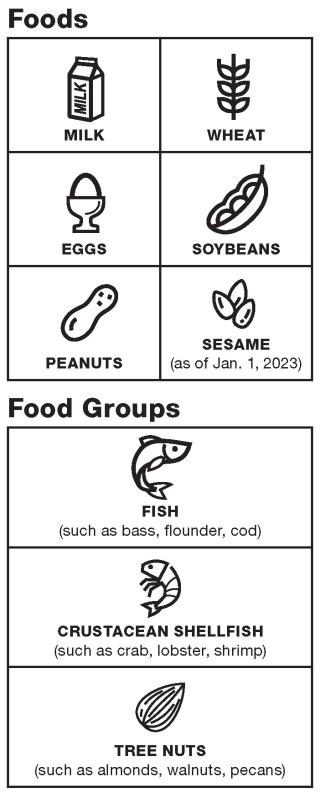Update on Food Allergen Labeling Requirements

Undeclared allergens on food labels are the leading causes of food recalls in the United States. The recent year-end 2022 updates to the Food Code and federal food-labeling regulations make it a great time for retailers to train employees about the top nine food allergens.
2022 Food Code Adds Sesame as 9th Allergen
Every four years, the Food and Drug Administration (FDA) updates the Food Code, and the latest 2022 edition last December reflects new legislation that took effect Jan. 1, 2023: The Food Allergy Safety, Treatment, Education and Research Act of 2021 — also referred to as the FASTER act – added sesame to the list of the top major food allergens.
The Food Code is a tool intended to ensure that food sold at retail is safe for consumers. While foodborne illness was the initial focus for many years, newer versions of the code also include food allergies that pose a significant risk to more than 50 million Americans. According to the Food Code, retail foodservice managers must know the nine major food allergens, must understand food allergen ingredient identities on food labels and must be aware of the serious health risks of food allergies.
Food Allergen Labeling for Unpackaged Foods
Informing customers in writing of the nine major food allergens as ingredients in unpackaged food is the biggest change that retailers need to know about when it comes to the latest 2022 Food Code and federal food-labeling requirements. Previous versions of the Food Code and FDA labeling regulations required all packaged foods, including foods packaged at retail, to identify major food allergens on labels. The new requirements extend this requirement to any bulk food available for consumer self-dispensing, such as prepared food sections, in-store bakeries with self-service bins, and food-sampling stations.
The Food Allergen Labeling and Consumer Protection Act of 2004 (FALCPA) requires food allergens to be labeled in plain English in the ingredient list, or in a “contains” statement printed immediately after or adjacent to the ingredient list. In November 2022, the FDA released two guidance documents that answer food industry members’ questions about labeling requirements. They include more in-depth clarification on the labeling of sesame, milk, eggs, tree nuts, fish and shellfish, as well as the labeling of dietary supplements. They also discuss exclusions and exceptions, such as those for soy oil and soy lecithin, as well as for “raw agricultural commodities” such as whole fruits and vegetables that may be sold in the fresh produce department. These documents include helpful images and examples of labeling requirements as well.
The 9 Major Food Allergens
As seen in the graphic, the FDA identifies “major food allergens” as one of the foods from one of the food groups listed in the graphic, or an ingredient that contains protein derived from one of the foods.
Unlike food-manufacturing facilities that may have separate areas or production timeframes that can eliminate and drastically reduce exposure to food allergens and cross-contamination, the retail food environment does not have many of the same luxuries. Confined space featuring food prep for multiple departments makes the potential for cross-contamination in retail supermarket food prep areas extremely high.
Retail Allergen Resources
To help retailers tackle the complexities of managing food allergen labeling and to help establish good retail practices (GRPs), FMI — The Food Industry Association released a Retail Allergen Resource Document in July 2022. It’s an invaluable resource to address recent regulatory updates, providing concrete steps that can get retailers up to speed with regard to managing new requirements. The FMI resource is set up to help retailers in four distinct areas to manage major food allergens: Customer Notification and Engagement, Training Retail Food Employees, Labeling Guidance to Comply with Regulations, and Retail Operations to Minimize Unintended Allergens.
Another helpful resource is a video, “FASTER Act Overview: FDA’s Perspective.” The 24-minute video, which is publicly available on YouTube, includes basic information and helps answer frequently asked questions from the food industry and other stakeholders.
New Areas in Store for Allergen Awareness
Although some shoppers with food allergies report that they avoid entire departments that may contain allergens, retailers have an opportunity to gain loyal customers by helping them find safe products. Clearly identifying allergens and cross-contaminants (of other allergens) for self-serve or unpackaged items sold in the deli/prepared food sections and bakery is now required as part of FALCPA and helps customers avoid health risks and retailers avoid unnecessary liability.
Helping shoppers with food allergy concerns is smart for business. They spend more overall on groceries and represent $19 billion in annual sales, growing at a rate of 4%, according to FARE (Food Allergy Resource & Education). They’re savvy shoppers who read food labels and take advantage of food allergy tools such as apps, online information, and in-store dietitian services if they’re available. Posting signage about the potential of major allergens and sharing information on safety protocols in place to limit cross-contamination go a long way in serving happy, healthy long-term customers.







